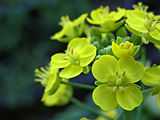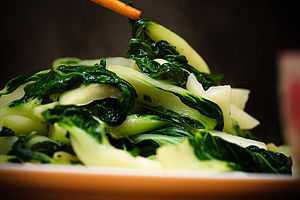Bok choy
| Bok choy | |
|---|---|
|
Brassica rapa chinensis, called "bok choy" in the United States | |
| Species | Brassica rapa |
| Cultivar group | Chinensis |
| Origin | China, before the 15th century |
Bok choy or pak choi (Brassica rapa subsp. chinensis) is a type of Chinese cabbage. Chinensis varieties do not form heads; instead, they have smooth, dark green leaf blades forming a cluster reminiscent of mustard or celery. Chinensis varieties are popular in southern China and Southeast Asia. Being winter-hardy, they are increasingly grown in Northern Europe. This group was originally classified as its own species under the name B. chinensis by Linnaeus.
Spelling and naming variations
| Green bok choy | |||||||||||||||||||
.jpg) | |||||||||||||||||||
| Chinese name | |||||||||||||||||||
|---|---|---|---|---|---|---|---|---|---|---|---|---|---|---|---|---|---|---|---|
| Chinese | 小白菜 | ||||||||||||||||||
| |||||||||||||||||||
| Korean name | |||||||||||||||||||
| Hangul | 청경채 | ||||||||||||||||||
| |||||||||||||||||||
Other than the ambiguous term "Chinese cabbage", the most widely used name in North America for the chinensis variety is bok choy (from Cantonese, literally "white vegetable"; also spelled pak choi, bok choi, and pak choy). In the UK, Australia, South Africa, and other Commonwealth Nations, the term pak choi is used. Less commonly, the descriptive English names Chinese chard, Chinese mustard, celery mustard, and spoon cabbage are also employed.
In Australia, the New South Wales Department of Primary Industries has redefined many of these names to refer to specific cultivars. In addition, they have introduced the word buk choy to refer to a specific kind of cabbage distinct from pak choy.[1][2]
In China, three terms are commonly used for this vegetable: the majority of Chinese (about 955 million) speak Mandarin, and for them the term of a northern variant of the vegetable is 油菜 yóu cài (literally "oil vegetable"); Shanghainese speakers (about 90 million in eastern China) use the term 青菜 qīng cài (literally "blue-green vegetable"); although the term 白菜 is pronounced "baak choi" in Cantonese, the same characters are pronounced "bái cài" by Mandarin speakers and used as the name for napa cabbage which they call "Chinese cabbage" when speaking English.
Nutritional value
| Nutritional value per 100 g (3.5 oz) | |
|---|---|
| Energy | 54 kJ (13 kcal) |
|
2.2 g | |
| Dietary fiber | 1.0 g |
|
0.2 g | |
|
1.5 g | |
| Vitamins | |
| Vitamin A equiv. |
(30%) 243 μg |
| Vitamin A | 4468 IU |
| Vitamin C |
(54%) 45 mg |
| Trace metals | |
| Calcium |
(11%) 105 mg |
| Iron |
(6%) 0.80 mg |
| Magnesium |
(5%) 19 mg |
| Sodium |
(4%) 65 mg |
| |
|
Percentages are roughly approximated using US recommendations for adults. Source: USDA Nutrient Database | |
Bok choy contains a high amount of vitamin A per 4 oz. of serving - about 3500 IU.[3] Bok choy also contains approximately 50 mg of vitamin C per 4 oz. serving.[3]
Chinese cabbage was ranked second for nutrient density out of 41 "powerhouse" fruits and vegetables in a peer-reviewed US Center for Disease Control study.[4]
Toxic effects
Bok choy contains glucosinolates. These compounds have been reported to prevent cancer in small doses, but, like many substances, can be toxic to humans in large doses, particularly to people who are already seriously ill. In 2009, an elderly diabetic woman who had been consuming 1 to 1.5 kg of raw bok choy per day, in an attempt to treat her diabetes, developed hypothyroidism, for reasons relating to her diabetes, resulting in myxedema coma.[5]
Gallery
-
Baby bok choy
-

B. rapa chinesis
-

B. rapa chinesis has yellow flowers
-

Cooked bok choy
References
| Wikimedia Commons has media related to Brassica rapa subsp. chinensis. |
| Wikibooks Cookbook has a recipe/module on |
- ↑ "Help is on the way for consumers confused by the wide array of Asian vegetables on sale". 2009-10-22. Archived from the original on 2007-08-20. Retrieved 2011-09-08.
- ↑ "Asian vegetable names" (PDF). Archived from the original (PDF) on 2006-10-30. Retrieved 2011-09-08.
- ↑ 3.0 3.1 Harlan, Dr. Timothy S. "Ingredients: Pak choi". Retrieved 2010-08-04.
- ↑ di Noia, Jennifer (2014-06-05). "Defining Powerhouse Fruits and Vegetables: A Nutrient Density Approach". Preventing Chronic Disease (National Center for Chronic Disease Prevention and Health Promotion (USA)) 11. doi:10.5888/pcd11.130390. ISSN 1545-1151. Retrieved 2014-06-11.
- ↑ Rabin, Roni Caryn (2010-05-24). "Regimens: Eat Your Vegetables, but Not Too Many". The New York Times. Retrieved 2010-06-03.
